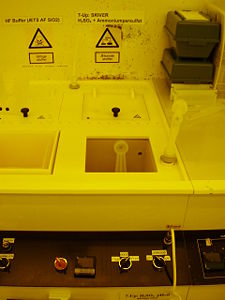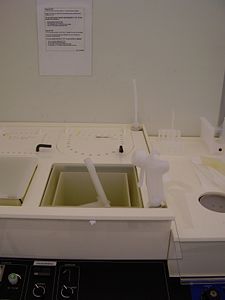Specific Process Knowledge/Wafer cleaning/7-up & Piranha: Difference between revisions
| Line 7: | Line 7: | ||
Samples not allowed or not compatible with these baths can be cleaned manually in a beaker filled with the so called "Piranha" mixture using one of the acids/bases fume hoods. This mixture consists of concentrated sulfuric acid and hydrogen peroxide forming very aggressive and reactive peroxide species (as in 7-Up) which is very effective at removing organic contaminents and to some extent some metal ions. | Samples not allowed or not compatible with these baths can be cleaned manually in a beaker filled with the so called "Piranha" mixture using one of the acids/bases fume hoods. This mixture consists of concentrated sulfuric acid and hydrogen peroxide forming very aggressive and reactive peroxide species (as in 7-Up) which is very effective at removing organic contaminents and to some extent some metal ions. | ||
Always use one of these cleaning procedures after KOH etch or hot phosphoric acid etch (Nitride etch) to remove alkali ions before further processing. 7-up and Piranha are always used as cleaning solutions '''after''' stripping resist if you have resist on your samples. Cleaning samples with resist coatings or significant amounts of other organic substances can be very dangerous, because 7-Up and Piranha are so aggressive. These solutions are intended for removing TRACES of organic matter. Adding large amounts of organics can lead to explosive reactions! | Always use one of these cleaning procedures after KOH etch or hot phosphoric acid etch (Nitride etch) to remove alkali ions before further processing. 7-up and Piranha are always used as cleaning solutions '''after''' stripping resist if you have resist on your samples. Cleaning samples with resist coatings or significant amounts of other organic substances can be very dangerous, because 7-Up and Piranha are so aggressive. '''These solutions are intended for removing TRACES of organic matter. Adding large amounts of organics can lead to explosive reactions!''' | ||
[[Image:7-up_RR3.jpg|300x300px|right|thumb|Wafer clean bath in cleanroom D3. <br\> -Up to 25 wafers of 4" or 6" at a time.<br\> -Materials allowed: Silicon, Poly Silicon, Silicon Oxide, Silicon Nitride, Silicon Oxynitride,Quartz/fused silica]] | [[Image:7-up_RR3.jpg|300x300px|right|thumb|Wafer clean bath in cleanroom D3. <br\> -Up to 25 wafers of 4" or 6" at a time.<br\> -Materials allowed: Silicon, Poly Silicon, Silicon Oxide, Silicon Nitride, Silicon Oxynitride,Quartz/fused silica]] | ||
[[Image:7-up_Mask.jpg|300x300px|right|thumb|Mask clean in cleanroom D3:<br\> -Up to 25 glass wafers of 4" at a time or 4 masks.<br\> -Materials allowed: Silicon, Poly Silicon, Silicon Oxide, Silicon Nitride, Silicon Oxynitride, Quartz/fused silica, glass (Pyrex and Soda Lime), chromium]] | [[Image:7-up_Mask.jpg|300x300px|right|thumb|Mask clean in cleanroom D3:<br\> -Up to 25 glass wafers of 4" at a time or 4 masks.<br\> -Materials allowed: Silicon, Poly Silicon, Silicon Oxide, Silicon Nitride, Silicon Oxynitride, Quartz/fused silica, glass (Pyrex and Soda Lime), chromium]] | ||
<!-- [[Image:7-up_RR3.jpg|300x300px|right|thumb| | <!-- [[Image:7-up_RR3.jpg|300x300px|right|thumb|Fume hood 01 and 02 in cleanroom D3<br\> -Up to 19 wafers of 4" at a time.<br\> -Materials allowed: Silicon, Silicon oxide, Silicon nitride, PolySi]]--> | ||
'''The user manual, user APV and contact information can be found in LabManager:''' | '''The user manual, user APV and contact information can be found in LabManager:''' | ||
Revision as of 10:46, 21 September 2017
Feedback to this page: click here
Cleaning of wafers or masks
Cleaning of wafers or masks can be done in dedicated baths ("Wafer clean" and "Mask clean" respectively). They are both located inside "Wet bench 03: Wafer and mask cleaning" and both contain concentrated sulfuric acid to which a little ammonium persulfate is added before use. This creates very reactive peroxide species that remove organic traces very efficiently. Historically this mixture has also been referred to as "7-Up" becauses it fizzes and bubbles similar to the 7-Up beverage.
Samples not allowed or not compatible with these baths can be cleaned manually in a beaker filled with the so called "Piranha" mixture using one of the acids/bases fume hoods. This mixture consists of concentrated sulfuric acid and hydrogen peroxide forming very aggressive and reactive peroxide species (as in 7-Up) which is very effective at removing organic contaminents and to some extent some metal ions.
Always use one of these cleaning procedures after KOH etch or hot phosphoric acid etch (Nitride etch) to remove alkali ions before further processing. 7-up and Piranha are always used as cleaning solutions after stripping resist if you have resist on your samples. Cleaning samples with resist coatings or significant amounts of other organic substances can be very dangerous, because 7-Up and Piranha are so aggressive. These solutions are intended for removing TRACES of organic matter. Adding large amounts of organics can lead to explosive reactions!


The user manual, user APV and contact information can be found in LabManager: 7-up 6" info page in LabManager or 7-up (masks) info page in LabManager
The APV for working with piranha in fumehood can be found by clicking here
Comparing the 7-up cleans and Piranha clean
| 7-up wafers | 7-up Masks | Piranha | |
|---|---|---|---|
| General description |
Cleaning of wafers using the dedicated tank in cleanroom D3. |
Cleaning of masks using the dedicated tank in cleanroom D3. |
Cleaning of wafers using a beaker in the fumehood in cleanroom B1. Used for glass wafers or wafers with metal or other materials that you are not allowed to put in the 7-up for wafers or masks. |
| Chemical solution | Sulfuric acid (98%) and Ammonium persulfate | Sulfuric acid (98%) and Ammonium persulfate | Sulfuric acid (98%) and Hydrogen peroxide (30%) in the ratio 4:1. First add H2SO4 into a glass beaker then add H2O21. |
| Process temperature | 80 oC | 80 oC | ~70 oC the chemicals will heat up to working temperature during mixing, therefore be careful! First add H2SO4 into a glass beaker then add H2O21. |
| Process time | 10 min. | 10 min. | 10 min. |
| Allowed materials |
|
|
All materials (in beaker). |
| Batch size |
1-25 4" or 6" wafers |
1-25 4" or 6" wafers or 1-4 5" masks |
1-5 4" wafer at a time |
| Size of substrate |
4-6" wafers |
4-6" wafers or 5" masks |
All sizes that can fit into the beaker in a dedicated holder |
Note 1: In preparing a solution involving an acid, always add the acid last. The exception to this rule is Piranha, in which case you add H2O2, which is a very strong oxidant, to H2SO4, which is a very strong acid. This is done because it is potentially explosive and at the very least will cause the solution to become very warm.
